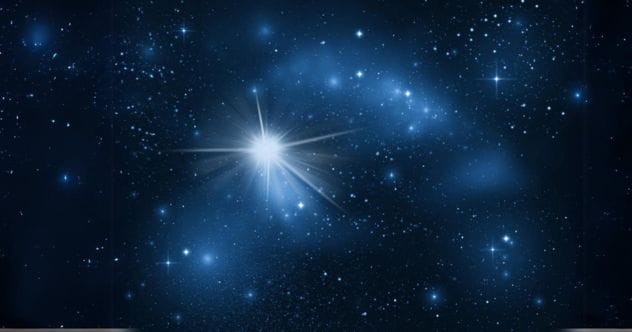Stars have always captivated us. The night sky, filled with countless stars, has inspired thinkers for millennia. Stars vary in shape, color and size. While many are spherical, some, like Vega, are ellipsoidal due to rapid rotation or complex gravitational forces within multi-star systems. Our own Sun is a spherical, yellow dwarf G-class star.
Sirius, also known as the “Dog Star,” shines brightly as part of the Canis Major constellation. This beautiful, bright white star has been recognized since ancient times as one of the most prominent celestial objects. Here are ten interesting facts about Sirius to enrich your understanding.
10. A Very Large Star
Imagine comparing a cherry tomato to a lime. If the cherry tomato represents the Sun, the lime approximates Sirius’s size relative to our star. Sirius boasts a higher luminosity and larger size. Although the Sun appears largest from Earth, this is due to our planet’s proximity. Perspective led ancient civilizations to believe Earth was the center of the Universe. Modern measurements have since reshaped scientists’ understanding of star sizes.
9. Hotter Than Our Sun
Understanding the universe involves classifying and organizing celestial objects. Astronomers use the Morgan-Keenan system to classify stars by temperature, assigning letters from hottest (O) to coldest (Y). Sirius is an A-class star with a surface temperature of about 17,432.6°F (9,667°C). For comparison, the Sun’s surface is around 9,930°F (5,500°C). The extreme heat of Sirius could melt any element into plasma.
8. Sirius’s Dwarf Star Companion
Sirius A has a white dwarf companion, Sirius B, a compact object orbiting the larger star. It’s the closest known white dwarf to our solar system, making it valuable for research. White dwarves are believed to be the cores of small to medium-sized stars that have gone supernova.
In the past, Sirius B was likely a much larger star, similar to Sirius A. Having two giant stars orbiting each other would have created an exceptionally bright light in Earth’s ancient skies, possibly even casting shadows at night.
7. Light Years Away
The immense distances between stars are difficult to fathom. If Earth were 1 mile from the Sun, Sirius would be 335,540 miles away, farther than the distance between Earth and the Moon. In reality, Earth is approximately 93 million miles from the Sun, while Sirius is about 50.5 quadrillion miles away.
This vast distance makes travel to Sirius impossible with current technology. Science fiction explores possibilities like generation ships, where successive generations complete the journey, or hibernation ships where astronauts sleep until arrival. However, the cost and complexity make interstellar travel to Sirius unlikely in the foreseeable future.
6. More Massive Than Our Sun
Sirius is almost twice the mass of the Sun. The Sun’s mass is about 2 nonillion kilograms, 333,000 times Earth’s mass. Sirius clocks in at roughly 4 nonillion kilograms. Such an immense mass of hot plasma is fortunate to be so far away, otherwise Earth would be scorched. A star of Sirius’s mass isn’t ideal for sustaining life on nearby planets.
Sirius’s stronger gravitational field would capture comets from a greater distance than the Sun. Many believe the Sun has an Oort cloud extending about 1 light-year. Sirius’s greater mass suggests it could capture comets even farther out, although no Oort cloud has yet been observed around Sirius.
5. No Known Exoplanets
Despite a thorough search in 2021, including observations of Sirius’s white dwarf companion, no exoplanets have been found in the Sirius system. This doesn’t rule out their existence; current instruments may lack the power to detect smaller, Jupiter-sized planets around Sirius. Detecting exoplanets is challenging.
To photograph exoplanets, the light from the parent star must be filtered out, a method used to visualize large exoplanets around stars like Fomalhaut. Unlike Sirius, the Fomalhaut system has a confirmed exoplanet, Fomalhaut b. More advanced telescopes are needed to definitively confirm whether or not the Sirius system hosts exoplanets. Currently, the consensus is that it doesn’t.
4. The Brightest Star
Sirius is the brightest star visible from Earth due to its size and relative proximity. Ancient civilizations, particularly the Egyptians, used Sirius to calibrate their calendars. The rising of Sirius at certain times helped them predict the Nile River’s floods, crucial for planning crop planting.
Before the Gregorian calendar, observing Sirius helped ancient Egyptians estimate the solar year at approximately 360 days. While slightly off the actual 365.24 days, Sirius played a vital role in their agricultural planning.
3. Approaching the Solar System
Sirius is moving towards our solar system at approximately 3.42 miles per second (5.5 kilometers per second) due to orbital mechanics and large-scale gravitational forces. Astronomers predict its closest approach will be 8.18 light-years or 47.9 trillion miles away.
Data from the Hipparcos satellite supported this prediction. This closest approach is expected to occur in about 46,000 years. Current research indicates no danger of Sirius coming too close to our solar system.
2. Described as a Red Star by Ptolemy
Most modern astronomers refute Ptolemy’s claim that Sirius was once red, citing ancient Chinese astronomers who reported it as white. The prevailing model suggests Sirius has remained a white star throughout human history. However, Claudius Ptolemy described Sirius as red around AD 150.
If true, this would significantly alter star aging models. One explanation is that the white dwarf Sirius B was once a red giant orbiting Sirius A. This could have caused the entire Sirius system to appear reddish in ancient times.
1. Brighter Than Our Sun
If Sirius were as close to Earth as the Sun, it would appear much brighter. Despite not being significantly larger, Sirius is substantially hotter and brighter, radiating 25 times more light than the Sun. This extreme brightness would likely scorch any exoplanets orbiting Sirius, making it improbable to discover lifeforms within the system, despite science fiction narratives.
For life to potentially exist, an exoplanet would need to be much farther from Sirius than Earth is from the Sun, or any lifeforms would need to adapt to intense temperatures, possibly living underground.
Sirius, the brightest star in our night sky, holds many fascinating secrets. From its immense size and heat to its influence on ancient calendars and future trajectory, Sirius continues to inspire awe and wonder. Exploring the cosmos reveals just how dynamic and complex our universe truly is.
What fact about Sirius surprised you the most? Leave your comment below!










